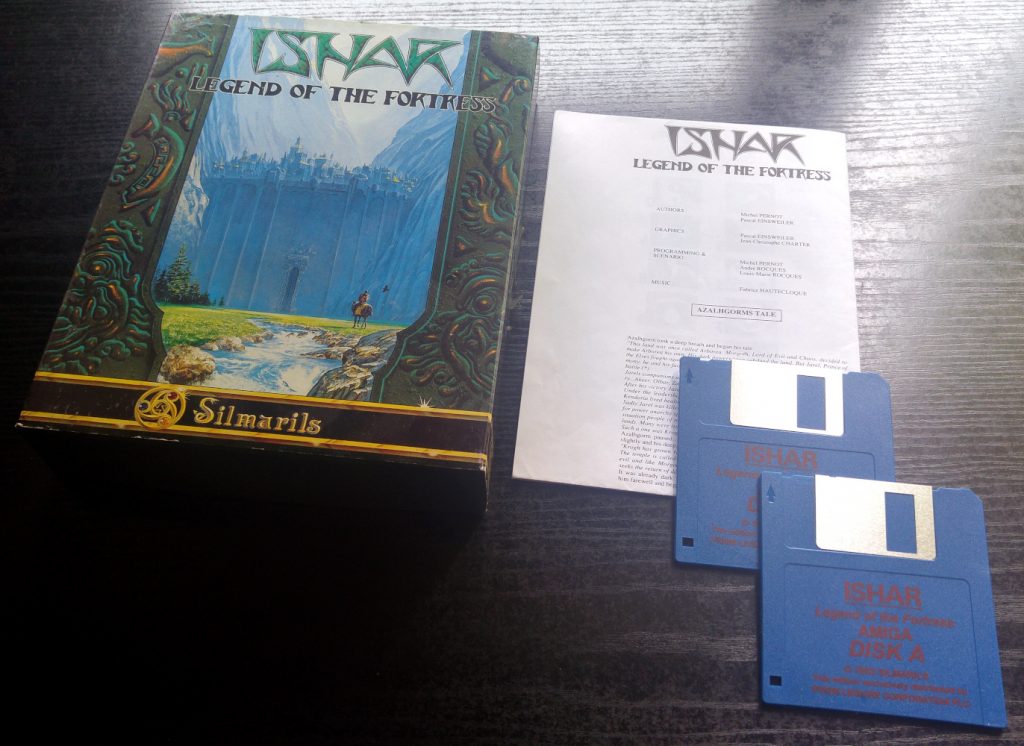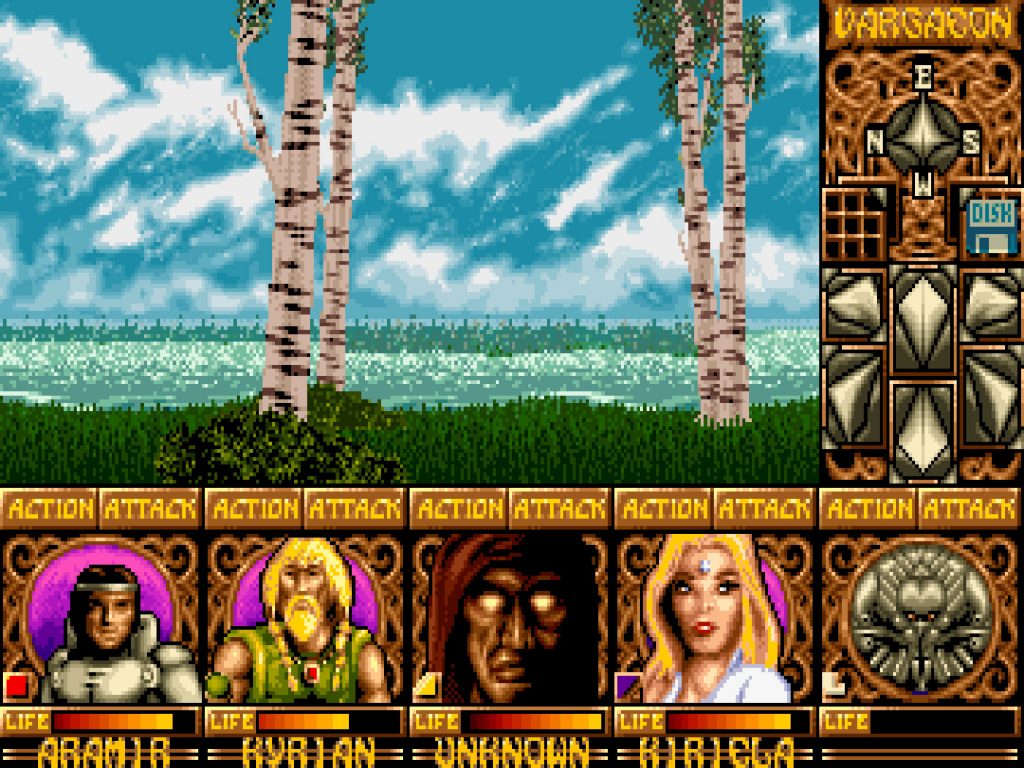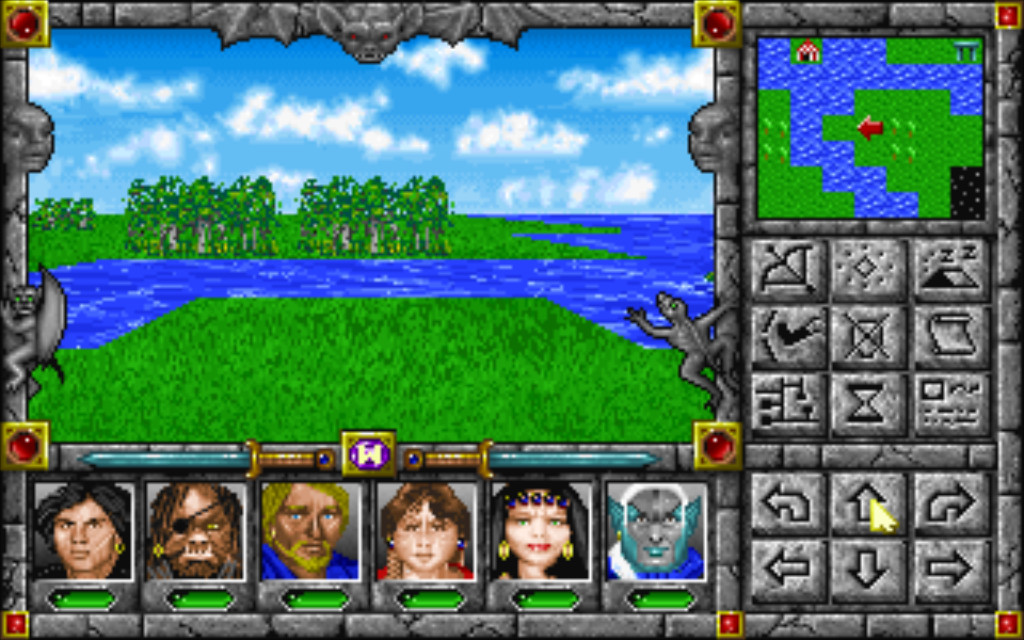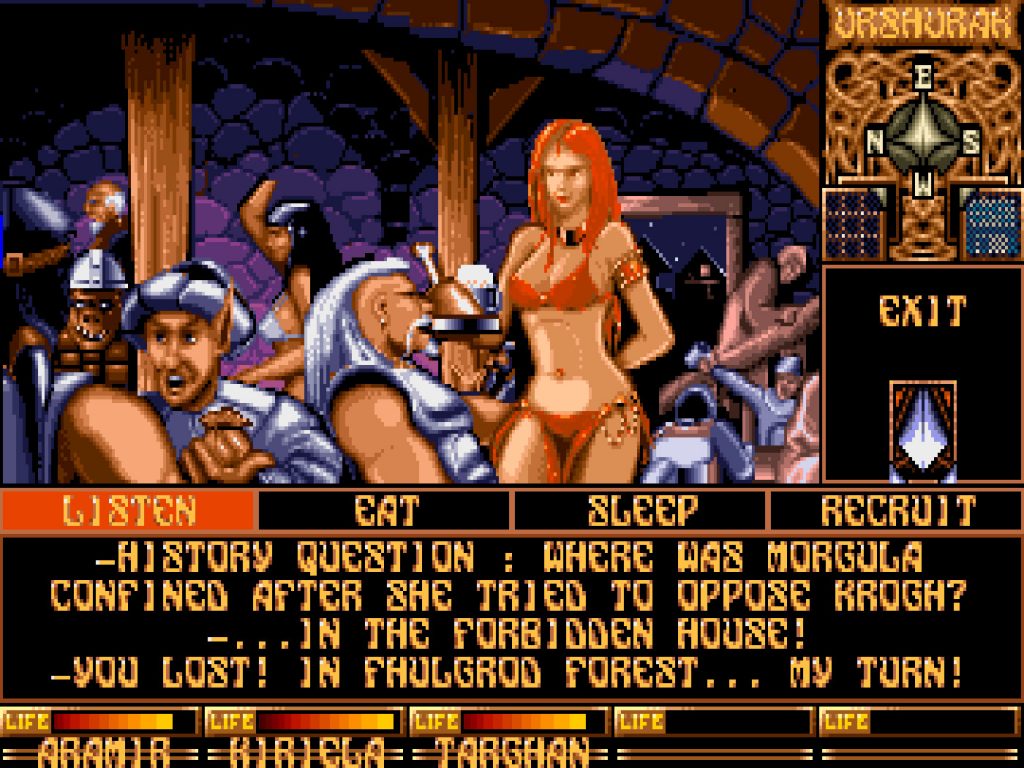
Recently I’ve completed Ishar for the second time and via GOG (first time I’ve done it on Amiga years ago). I like this game despite myriad of issues I have with it. In fact I like it enough that I have an inclination to one day create a video game in a similar vein. I thought about why am I fond of it.
Presentation
In large part it has to do with the audio-visual side of the game. The world is pleasingly colourful: green grass contrasts with blue sky and white clouds. Detailed vegetation interrupts monotonous terrain. Objects lose colour with distance which imitates fog.
Yellow interface contrasts nicely with the world screen. It features a fancy pattern and diamond-shaped arrows as movement cursors.

Environment pieces are large and detailed. You can get lost in the mighty, dense forests. Tall city walls stand firm in the distance. Inside them you’ll find a dense, sand-coloured labyrinth. Houses are big and timber-framed which gives them a medieval look. Interiors greet you with a large, decent art piece. Dungeon doorways are ornamented with menacing sculptures. Inside you’ll find a nice stone texture. Monsters that you encounter have a threatening appearance.
Now look at Might & Magic IV which was released in the same year and plays very similarly. Its graphics are much less rich. Terrain borders have straight angles and textures are poorer. Vegetation is the same sprite copy-pasted and when you move closer it is zoomed-in (pixelated) which looks awful. Towns (on the outside) are rendered as miniatures which looks puny. There’s no distance fog and pieces just pop in to the view. Inside taverns you get a nice animated screen but other interiors consists of a tiny portrait and a wall of text.

When you compare the two you realize that a lot of effort went into Ishar’s visuals.
The land of Kendoria is homogenous (woodland) while the world of Xeen features a mish-mash of different environments akin to a theme park ride. The latter has a greater variety of enemies and some of them are rather silly (like court jesters juggling balls).
Your journey in Ishar is accompanied by a monotonous wind sample with occasional noises of the fauna. Near water you can hear the sound of waves and frogs. When you move to a different area (like forest) wind suddenly dies down which raises your alertness.
M&M has only a few sound effects and they aren’t pleasant.
In Ishar’s dungeons you can hear laughs of unknown source and I was scared the first time I heard it. I wonder how did the authors came up with this. For me everything has to be foreshadowed, explained and logical. Random laughs do not make sense and yet they are effective here.
There are places where presentation is lacking. There’s no indication which houses you can enter and which you can’t (except for city shops) leading to a trial and error. Later in the game you meet the same of type of enemies yet clearly stronger. Just a simple color shift could have shown that it’s not exactly the same opponent. The cites could have been more visually diverse and have sound effects instead of being completely silent. In houses you meet the same character drawing just with a different head. Also Deloria’s sprites are awful.
Tile-based games have particular pacing where pieces can suddenly and unpredictably jump from one place to another. Compare it to 3D games where objects slowly and smoothly “grow” on the screen. While playing Ishar I did get startled a few times when a monster instantly popped on the screen followed with a sound effect of a character being hit.
Gameplay
You start in an unknown land equipped with a vague map and an orientation skill. As you explore the land you find hints what to do next. I like that you aren’t given much information. It’s fun to figure things out yourself (given reasonable clues) rather than having everything spelled out for you.
For example you’ve heard that there’s something to find in Lotharia. You “use orientation” to check the names of neighbouring regions. Then turn around to face the desired direction on the compass and start marching looking for a way through. You know you’ve reached your destination when the interface displays “Lotharia”. Now to look for that specific thing…
The game is about exploration. You are rewarded for being nosy but also constrained by characters vitality and energy. Healing is costly, food carrying capacity is limited and enemies reappear so you have to be careful and plan your trips.
Almost everything that you find in the game is important (it leads you toward completion). There are no generic dungeons with generic, randomized items.
Combat is done in real-time. Most of the enemies quickly move towards you and strike first. Fighting is a frantic experience where you’re desperately trying to find attack keys on the keyboard and then mash them while constantly receiving hits. In M&M monsters “wait” for you to move and the combat is turn-based so it doesn’t have the same sense of urgency.
Defeated enemies don’t drop generic items (some of them drop gold) so there’s no mess in your inventory. You cannot sell any items so there’s no reason to carry around obsolete stuff and subsequently you won’t end up with a ton of gold made from sales. Unfortunately farming is still possible and so in the mid-game money diminishes as a limiting factor.
I mentioned before that enemies respawn and besides limiting your travel and making farming an option it also creates a constant sense of danger. In M&M you can “clean” the world and feel safe.
I also like the lack of formalization. There are no official quests and side-quests. You just… play the game. Characters levelling is done in the background and doesn’t interrupt you. Attribute improvement is still possible but it’s embedded in the game world.
On the other hand, Ishar is too vague when it comes to its mechanics. I thought that manual would explain everything but it doesn’t (and is even wrong where it says that eating restores vitality while in fact it restores energy). The game doesn’t tell you if your action succeeded or failed or if it’s even valid. This lack of information results in player’s confusion. For example: why can’t I defeat a monster? Is it because of low attributes or low experience or poor weapon or low energy? You learn how the game operates by trial and error which I don’t find very enjoyable.
Another issue I have is that Ishar features mechanics that are almost or completely useless:
- Lockpicking. You can find all the keys in a dungeon jut by walking around. Even the best burglar can’t open all the doors and hiring him just for this purpose is a waste of a precious character slot.
- First Aid. The amount of vitality you receive is minuscule.
- Skill duplication. Values of “one-handed” and “two-handed” are very similar to each other for every character so there’s no reason it couldn’t be merged into a single number. Similar with “throwing” and “shooting”.
- Ranged combat is tedious. You have to buy arrows (and you can only carry a certain amount), run away from the enemies and then meticulously click on them. Melee combat is simpler because you only have to mindlessly mash keys. Archery was done much better in M&M where it’s a complementary fighting method (though it’s too weak in late game).
- Magic. Most of the spells are just not worth the effort.
- Languages skill. I have no idea what it is for.
- Team cohesion. Characters can like and dislike each other which affects if you can hire them, dismiss them, if they can provide first aid or if they will abandon the party. This sounds like an interesting idea but in practice the most optimal characters work fine with each other. Options to kill or dismiss a character don’t matter when you can just let a member be killed by monsters.
- Characters. There are 32 of them in total and not much reason to hire most of them because you meet powerful ones early in the beginning. Targhan is the second-best fighter. Sheelda is the second-best archer. Azirek is the best at lockpicking. Kiriela is a very good early magician (she even has spells that aren’t normally available for her class).
- Training. You can complete the game just fine without improving your characters at all. Only one exception is for the wizard to learn “Mental Shield” spell.
- Gear selection. There is a bunch of weapons yet I see no reason to buy most of them. Once you get to the first city you have access to the weapon with the highest stat (Heavy Axe) and that ends any further shopping choices. There are items with the same stats (axe and short sword, flail and long sword, heavy sword, mace and spear). What’s the difference between them? Is that a ploy to make player waste money? Is crossbow better than bow? What’s the effectiveness of shield vs double-wield?
Some parts of the game are straight-up unfriendly for the players:
- Saving costs money
- You can easily ruin the game by accidentally thrashing an important item.
- In the first dungeon there’s a trap that leaves you completely stuck. Authors are punishing save scumming but at the same time easily locking players out of victory.
- One trap works retroactively on newly hired characters.
- You have to find an unmarked enter-able house in the city.
- Potion seller doesn’t tell you the price so you have to guess it by wasting money.
- Training success is random which is particularly egregious because you see your hard-earned money go to waste due to bad dice rolls.
Story
There’s not much of it in Ishar and the bits that exist do not make much sense. I think it’s a shame because you would get invested more if there was a decent exposition.
Azalhgorm from the manual seems to contradict the one in the game. What are Rune Tablets for? How do they work? Why are they spread across the land?
In comparison in M&M you need to obtain a special weapon and I know exactly why – it’s the only way you can hurt the main bad (regular weapons are ineffective).
The main title (as well as the game box) shows you a beautiful fortress art. You would think that’s where you’re headed but instead you go through back door (I guess) in a dark dungeon. Is Ishar a fortress or a temple? Why it’s called “unknown” anyway? What exactly kind of powers it has? Is it evil in itself or is its user evil? The temple seems to have initiates. What’s in it for them? Why was Deloria kidnapped by Krogh’s thugs and brought to Elwingil?
Some of the clues that you get in the taverns are painfully unsubtle:

The word “history” implies that it happened a long time ago while appearance of Krogh seems recent. So it’s public knowledge and nobody ever did anything with the pig and it’s just there all the time? One tip mentions “City of Kandomir” but it turns out to be a single house.
Still, the game has some interesting ideas:
- A region where you can’t see
- Invisible enemy in the forest attacking you (this was scary for me the first time) and you can’t deal with him unless you wear a special helmet.
- Character transformed into a pig and you’ll have to reverse the spell.
- House with an invisible trap that causes you to slowly lose vitality.
- Party member falling in love with a damsel in distress and not letting her go unless you create a potion from turtle’s drool
Ishar ends in an awfully unsatisfying manner by showing you a boring art piece. It actually freezes the game and the only thing you can do is to terminate the program.
Conclusion
Ishar is a relict of the past where we still didn’t know much about game design. It seems like the authors just threw stuff out there making it look like an RPG without giving much thought into it.
Since then the designers have learned to teach players about the mechanics, make fair challenges, make choices matter and communicate how effective player’s decisions are going to be. They explain why players are doing what they’re doing and provide backstories.
This game succeeds in creating an impression of a realistic, dangerous world and having an unnerving atmosphere. M&M is more playful and relaxed (you get rewards often; even death is not a big deal).
Ishar presents a somewhat decent challenge where player has to find and connect the dots. There’s no padding or busywork. Modern games hold your hand (with automaps, quest markers, objective hints etc), give you a ton of insignificant fetchquests or make you focus extensively on inventory management so I think there’s still something to learn from the old games.
P.S. Here are my spreadsheets with the game info. See also impressive guide on OldGames.sk.